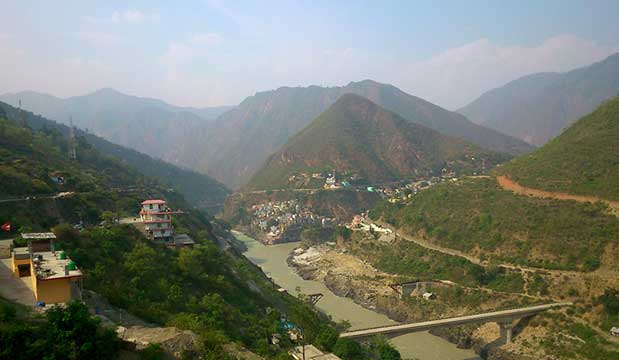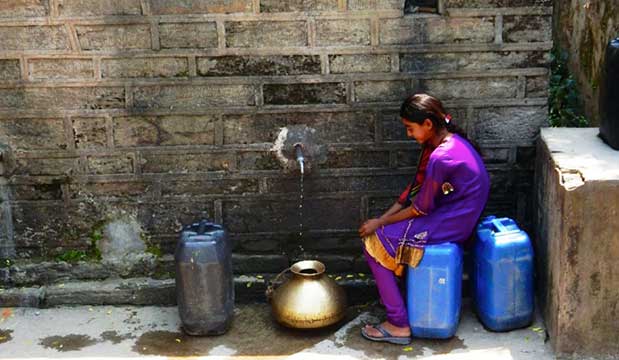By Sudeshna Maya Sen
There is an old Indian proverb, ‘chiraag tale andhera’, which means that although a lamp illuminates everything around it, it is still darkest under the lamp. This proverb resonates across many villages in Devprayag tehsil with regards to water availability. Devprayag is witness to one of the most majestic confluences of rivers—the Alaknanda and the Bhagirathi—to form the Ganga, yet a stark contrast exists, wherein the villages scattered along the mountainside face severe water crunch every day even though the rivers flow right below them. Here is a classic case of water being available yet inaccessible.
 Confluence of Alaknanda and Bhagirathi rivers at Devprayag in the Upper Ganga river basin
Confluence of Alaknanda and Bhagirathi rivers at Devprayag in the Upper Ganga river basin
Harriet, my colleague from ICIMOD, and I reached the villages of Devprayag after a four-hour thrilling car ride along the mountains from Dehradun. The village we visited was Pyunkhari, which was nestled along the mountainside near the winding road leading to Tehri Garhwal. A short walk on the hillside (15 minutes for me, five minutes for the locals) took us to this small village with 37 households and a population of 189 individuals. We spoke to the inhabitants there regarding the various problems that they face and water scarcity emerged as the biggest concern of the people there. In recent years, rainfall has reduced a lot impacting not only the inhabitants’ rainfed agriculture but also the forest cover. However, an even bigger problem that they face is related to water for drinking and domestic use.
Earlier, we were informed that the main source of drinking water for these villagers was the springs. Today, ill-conceived construction and increased concretisation of structures have led to the drying up of most natural water sources. A few springs that still exist become active only during the monsoons and even this water is not potable due to the poor water quality. Currently, the water supply to the village is a common tank that is supplied through a network of pipes that lifts water from the Alaknanda River through the Bhagwan Pumping Scheme. However, this supply is inadequate, erratic, and unreliable as it only flows once in 2–3 days. When we were there, the water in the pipe had reduced to a trickle, and ironically enough, it was supposed to be a ‘water supply day’.
When water availability decreases in these villages, women become the most vulnerable and their drudgery seems to increase. The collection of water is considered a domestic chore and falls under the domain of a woman’s job. With increased water shortage, especially in summers, women are forced to travel 8¬–10 kilometres to collect water in addition to their other domestic chores. There are no handpumps in the village; there are some provided at certain locations along the road downhill but they often don’t work. I had a very hard time and was out of breath even climbing up the short distance, and it is so difficult to imagine doing the same multiple times (at least 10 times) with head-loads of watering cans. Moreover, collecting water is one of the countless jobs women are expected to carry out besides cooking, collecting firewood, and even working in agricultural fields. Since a lot of men have migrated to other areas in search of better jobs women are left to fend for themselves and their families till the men return.

A girl waiting at the tap for her pot to fill
The story that I observed here is similar for most villages in this stretch. Lack of access to water is the main reason for the increasing vulnerability of these villages. Despite many national policies existing on paper for the provision of adequate and safe drinking water to all the households in rural India, there is a huge gap in reality. I feel a sustainable way to provide water for domestic use and relieve pressure on women might be to rejuvenate the already existing interconnected network of naturally occurring spring water in the region. Till these changes happen the state of these villages can be summarized by these words of a local woman “Saari nadiya yahin se behti hain, par hum phir bhi pyaase hain” (“All the rivers flow through our lands and yet we are thirsty”).
